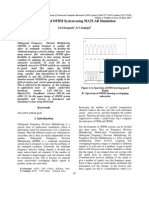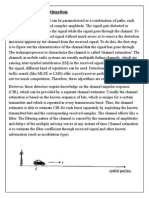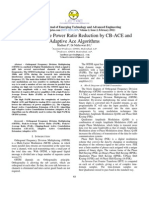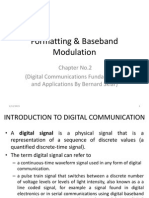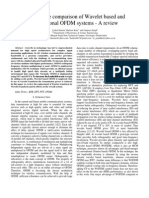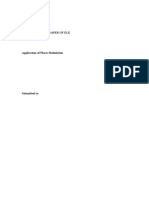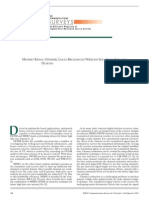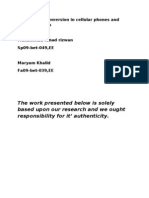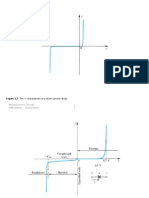Modeling of An ADSL Transceiver Data Transmission Subsystem: Elmustafa Erwa
Modeling of An ADSL Transceiver Data Transmission Subsystem: Elmustafa Erwa
Uploaded by
Irving Peña BalderasCopyright:
Available Formats
Modeling of An ADSL Transceiver Data Transmission Subsystem: Elmustafa Erwa
Modeling of An ADSL Transceiver Data Transmission Subsystem: Elmustafa Erwa
Uploaded by
Irving Peña BalderasOriginal Title
Copyright
Available Formats
Share this document
Did you find this document useful?
Is this content inappropriate?
Copyright:
Available Formats
Modeling of An ADSL Transceiver Data Transmission Subsystem: Elmustafa Erwa
Modeling of An ADSL Transceiver Data Transmission Subsystem: Elmustafa Erwa
Uploaded by
Irving Peña BalderasCopyright:
Available Formats
1
Modeling of an ADSL Transceiver Data Transmission Subsystem
Elmustafa Erwa
ABSTRACT
Recently, there has been an increase in demand for digital services provided over the
public telephone line network. Asymmetric digital subscriber lines (ADSL) transmit high
bit rate data in the forward direction to the subscriber, and lower bit rate data in the
reverse direction to the central office, both on a single copper telephone loop. In this
paper I present a survey on the recent research and standardization of ADSL transceivers.
I propose to model and simulate an ADSL transceiver using Synchronous Data Flow
(SDF).
1. INTRODUCTION
With the emergence of the Internet as the cornerstone to most of the
communications in this age, the demand for high speed Internet access has only been
increasing. Asymmetric digital subscriber lines (ADSL) is one of the technologies that
provide high-speed Internet access in residences and offices [1]. It facilitates the use of
normal telephone services, Integrated Services Digital Network (ISDN), and high-speed
data transmission simultaneously. Hence, bandwidth-demanding technologies, such as
video-conferencing and Video-on-demand, are enabled over ordinary telephone lines.
The European Telecommunications Standards Institute (ETSI) and the American
National Standards Institute (ANSI) have defined standards for ADSL transceivers. Both
of these standards propose the use of discrete multi-tone (DMT) as the modulation
technique for ADSL transceivers. DMT divides the effectively band-limited
communication channel into a larger number of orthogonal narrowband subchannels.
This allows for maximizing the transmitted bit rate and adapting to changing line
conditions.
2
In this literature survey, I briefly discuss the recent research and standardization
of ADSL transceivers. I also propose to model and simulate an ADSL transceiver using
Synchronous Data Flow (SDF).
2. BACKGROUND
2.1. ADSL Architecture
ADSL transmits data over frequencies up to 1.1 MHz. The limit of 1.1 MHz is
due to power constraints imposed by the Federal Communications Commission (FCC).
The 1.1 MHz bandwidth is divided into 256 narrowband subchannels downstream (from
the service provider to the customer) and 32 subchannels upstream (from the customer to
the service provider). Each 4.3 kHz narrowband subchannel has a separate carrier, and
the carriers are harmonically related. This type of data transmission is known as DMT
modulation, which is the type of multicarrier modulation proposed in the ADSL technical
specification.
The first channel in ADSL (0-4.3 kHz) is always dedicated for voice. The rest of
the channels are specified differently according to two different methods: 1) Frequency
Division Multiplexing, where upstream and downstream channels use different
frequencies, and 2) Echo Cancellation, where upstream and downstream channels
overlap. In the latter case, echo cancellation techniques make the channels independent.
2.2. ADSL Impairments
The performance of ADSL systems faces degradations due to severe channel
attenuation, Intersymbol interference (ISI) or Interblock Interference (IBI), and other line
impairments including crosstalk, additive white Gaussian noise and impulse noise. The
effective length of the channel impulse response v will cause IBI as the tail of the
3
previous ADSL block symbol will corrupt the beginning of the current block symbol,
hence the name IBI [2].
Crosstalk is caused by electromagnetic radiation due to other signals that are
traveling in adjacent or nearby cables. Near-end crosstalk (NEXT) is caused by signals
that are traveling in the same direction, while far-end crosstalk is caused by signals
traveling in the opposite direction. Both NEXT and FEXT increase with frequency. Table
1 shows the attenuation of a signal traveling at 1.1 MHz in a 24 gauge wire relative to the
length of the wire.
Table 1. Attenuation of a 24 gauge wire signal at 1.1 MHz.
2.3. Discrete Multi-tone Modulation
The fundamental goal of multicarrier modulation techniques is to partition a data
transmission channel with ISI into a set of orthogonal, memoryless subchannels, each
with its own carrier [2]. Data is transmitted through each subchannel independently of
other subchannels. Previous research has shown that such a system is capable of
transmitting at the highest data rate when allocating more bits and energies to
subchannels with higher signal-to-noise ratio (SNR) [3, 4]. DMT modulation is one of
4
many multicarrier techniques including Vector Coding, Structured Channel Signaling,
and Discrete Wavelet Multi-tone Modulation.
DMT based systems uses Quadrature Amplitude Modulation (QAM) to encode
the input bit stream into a finite set of symbols in a one-to-one mapping of integers in [0,
N-1] to complex numbers, where N is a power of 4. Each subchannel carries one QAM
symbol. The number of bits that can be used to generate the QAM symbol in the ith
subchannel with an estimated SNR
n
is approximately given by
) 1 ( log
2
+ =
n
n
SNR
b (1)
where the gap I 9.8 dB ,
m
,
c
for a bit error rate of 10
-7
[4]. The quantity ,
c
is coding
gain of the applied code and ,
m
is the margin. The optimum assignment of bits to each
subchannel, which is not necessarily an integer value, is found using bit loading
algorithms [4]. In the case of non integer assignment, bits are truncated or rounded to the
nearest fraction that can be implemented by multidimensional trellis codes.
DMT modulation and demodulation is implemented using the Inverse Discrete
Fourier Transform (IDFT) and Discrete Fourier Transform (DFT). To implement an N/2
subchannel DMT system, an N size IDFT/DFT is required. The size is doubled by
mirroring the data to impose conjugate symmetry in the frequency domain, which results
in real-valued signal in the time domain after applying the IDFT. The general structure of
a DMT system is illustrated in Figure 1, where {X
0
, X
1
, , X
N-1
} are the original
complex QAM symbols, {x
n
} is the modulated data sequence, {y
n
} is the received
sequence, and {Y
0
, Y
1
, , Y
N-1
} are the decoded complex QAM symbols. The IDFT
and DFT are implemented very efficiently using the well known Inverse Fast Fourier
Transform (IFFT) and Fast Fourier Transform (FFT) algorithms.
5
Figure 1. Basic Discrete Multi-tone scheme.
2.4. Initialization and Channel Identification
In order to optimize the bit allocation in the subchannels, the transmitter acquires
an estimate of the channels impulse response and crosstalk noise spectrum before the
data transmission begins. This process is known as the initialization phase if it was before
the first ADSL block symbol. Otherwise, if the estimates are acquired in the middle of
the communication process between the transmitter and receiver, the process is known as
channel identification phase. During these two phases the transmitter and receiver do the
following: 1) Define a common mode of operation and clock and symbol
synchronization, 2) identify the channel, 3) calculate the optimal bit and energy
allocations for each subchannel, and 4) exchange the bit and energy allocation tables [5].
6
Figure 2. A block diagram of an ADSL Transceiver [6]
3. MODELING AND SIMULATION
3.1. ADSL Transmitter
In the ADSL transmitter shown in Figure 2, an input bit stream is first partitioned
into substreams using a serial-to-parallel (S/P) converter. Each substream is then
encoded using quadrature amplitude modulation (QAM), which produces a complex
number representing each encoded bit substream as mentioned in an earlier section. The
outputs of the QAM encoder are mirrored and conjugated before they enter an N point
IFFT, where N/2 is the number of subchannels. The mirroring creates real values at the
output of the IFFT. To mirror the data for M subchannels, N = 2M, the QAM symbols Xi
are given by [1] as
.
parallel to
serial
QAM
decoder
Freq.
domain
EQ
serial to
parallel
QAM
encoder
Input
bit
stream
mirror
data
and
N-IFFT
add
cyclic
prefix
parallel
to serial
DAC and
transmit
filter
N-FFT
and
remove
mirrored
data
serial
to
parallel
remove
cyclic
prefix
ADC, time
domain
EQ, and
receive
filter
channel
Detected
bit
stream
TRANSMITTER
RECEIVER
N/2 channels
N channels
N/2 channels
N channels
7
The IFFT then maps each QAM symbol into orthogonal frequency bins producing a
discrete multitone symbol of N samples. To form a frame, the last v samples of the
symbol, known as the cyclic prefix (CP) are copied and prepended to the symbol. This
provides a buffer against Interblock Interference (IBI), which was discussed earlier.
Unfortunately the addition of the CP decreases the transceiver power efficiency by a
factor of N/(N+ ) [7]. The final two stages serialize the data and convert it to analog via
the parallel-to-serial (P/S) converter and digital-to-analog (DAC) converter respectively.
3.2 ADSL Receiver
An ADSL receiver receives the data through the channel, which is modeled as an
FIR filter. The operation of the receiver is the dual of that of the transmitter, plus the
addition of an equalizer. The equalizer has two tasks: 1) reduce ISI in the time domain
and shorten the channel impulse response to the CP limit, and 2) compensate for
magnitude and phase distortion in the frequency domain [7]. The first task is done by the
time-domain equalizer (TEQ), while the latter is performed by the frequency-domain
equalizer (FEQ).
4. PROPOSED WORK
The three models of computation that can be used to model the ADSL transceiver
are Dynamic Data Flow (DDF), Synchronous Data Flow (SDF), and Timed Synchronous
Dataflow (TSDF). Figure 3 illustrates the model that is used for each of the blocks in the
ADSL transceivers based on the color of the node.
SDF is best for modeling Digital Signal Processing (DSP) communication
systems because of the static number of inputs and outputs in each node, and the
sequential transfer of data from one node to the next in an acyclic graph [8]. DDF is used
8
in this model due to the initialization and channel identification phases, which
dynamically change the bit allocation for each subchannel based on the channel
estimates. TSDF is used to model continuous time after the conversion of data from
digital to analog via the DAC.
My goal for this project is to model and simulate ADSL transceivers using SDF as
the model of computation. If time permits, I will try to extend the modeling to include
DDF and TSDF. In my simulations, I will attempt to evaluate the bit error rate for
different combinations of channel models, TEQs, and bit allocation tables.
Figure 3. Models of Computations
mirrored
data and
N-IFFT
QAM
S
/
P
FEQ
CP
P
/
S
DAC
Channel
TEQ
ADC N-FFT
and
remove
mirrored
data
QAM
S/
P
C
P
P/
S
DDF SDF
TIMED
SDF
9
5. REFERENCES
[1] Thomas Starr, John M. Cioffi, and Peter J. Silverman, Understanding Digital Subscriber Line
Technology (CD-ROM included), Prentice Hall PTR, 1999, ISBN 0-13-780545-4.
[2] P. S. Chow, J. M. Cioffi, and J. A. C. Bingham, "DMT-based ADSL: concept, architecture, and
performance," IEE Colloquium on High speed Access Technology and Services, Oct. 19, 1994.
[3] P. S. Chow, J. M. Cioffi, and J. C. Tu, "A discrete multitone transceiver system for HDSL
applications," IEEE Journal on Selected Areas in Communications, Volume 9, Issue 6, pp. 895-
908, Aug. 1991.
[4] P. S. Chow, J. M. Cioffi, and J. A. C. Bingham, "A practical discrete multitone transceiver loading
algorithm for data transmission over spectrally shaped channels, IEEE Transactions on
Communications, Vol. 43, Issue 2, Part 3, pp. 773-775, Feb.-March-April 1995.
[5] D. Arifler, M. Ding, and Z. Shen, "Modeling and simulation of discretized data transmission in
very high-speed digital subscriber line, Literature Survey for EE 382C Embedded Software
Systems, The University of Texas at Austin, Austin, TX, March 2002.
[6] G. Arslan, "ADSL Transceivers", Presentation for EE 379K-17 Real-Time Digital Signal
Processing Laboratory, The University of Texas at Austin, Austin, TX, November 15, 1999.
[7] P.J.W. Melsa, R.C. Younce, and C.E. Rohrs, Impulse response shortening for discrete multitone
transceivers, IEEE Transactions on Communications, vol. 44, pp. 1662-1672, Dec. 1996.
[8] A. Lee and D. Messerschmitt, "Synchronous data flow", Proceedings of the IEEE, vol. 75, no. 9,
pp. 1235-1245, Sep. 1987.
[9] B. Hirosaki, An orthogonally multiplexed QAM system using the discrete Fourier transform,
IEEE Transactions on Communications, vol. COM-29, pp. 982-989, July 1981.
[10] K. Kerpez and K. Sistanizadeh High bit rate asymmetric digital communications over telephone
loops, IEEE Transactions Communications, vol. 43, June 1995.
[11] B. R. Saltzberg, Performance of an efficient parallel data transmission system, IEEE
Transactions on Communications Technology, vol. COM-15, pp. 805-811, Dec. 1967.
[12] S. Darlington, On digital single-sideband modulators, IEEE Transactions on Circuit Theory,
vol. CT-17, pp. 409-415, Aug. 1970.
[13] J. A. C. Bingham, Multi-carrier Modulation for Data Transmission: An Idea Whose Time Has
Come, IEEE Communication Magazine, vol. 28 no. 5, pp. 5-14, May, 1990.
You might also like
- An Experimental Study To Reduce The Effect of ICI in OFDM Based WLAN SystemDocument4 pagesAn Experimental Study To Reduce The Effect of ICI in OFDM Based WLAN SystemSandeep Kaur BhullarNo ratings yet
- Ijtra 140812Document3 pagesIjtra 140812Akshay Kumar PandeyNo ratings yet
- Analysis of Wavelet Based OFDM SystemDocument8 pagesAnalysis of Wavelet Based OFDM Systemhk_sonuNo ratings yet
- Comparative Analysis of Ber Performance of DWT Based Ofdm System With Conventional FFT Based Ofdm SystemDocument6 pagesComparative Analysis of Ber Performance of DWT Based Ofdm System With Conventional FFT Based Ofdm Systemhk_sonuNo ratings yet
- Physical Media Dependent Sublayer With Effective Randomization For Welch Spectrum Shaping of Fixed Broadband Wireless AcessDocument7 pagesPhysical Media Dependent Sublayer With Effective Randomization For Welch Spectrum Shaping of Fixed Broadband Wireless AcessSudipta GhoshNo ratings yet
- Performance Analysis of MIMO-OFDM System Using QOSTBC Code Structure For M-QAMDocument12 pagesPerformance Analysis of MIMO-OFDM System Using QOSTBC Code Structure For M-QAMNoha HassanNo ratings yet
- Implementation and Performance Evaluation of OFDM System in Diverse Transmission Channel Using SimulinkDocument7 pagesImplementation and Performance Evaluation of OFDM System in Diverse Transmission Channel Using SimulinkAbdallah ToolmakerNo ratings yet
- Lecture 20: Switching and Multiplexing II: ECE 333: Introduction To Communication Networks Fall 2001Document9 pagesLecture 20: Switching and Multiplexing II: ECE 333: Introduction To Communication Networks Fall 2001mahemed mamounNo ratings yet
- An Introduction To Orthogonal Frequency Division MDocument7 pagesAn Introduction To Orthogonal Frequency Division Msamin76020No ratings yet
- Introduction of Orthogonal FrequencyDocument8 pagesIntroduction of Orthogonal FrequencysmuthsuddyNo ratings yet
- Behaviour of OFDM System Using MATLAB SimulationDocument5 pagesBehaviour of OFDM System Using MATLAB Simulationsreekanthreddy peramNo ratings yet
- What Is Channel EstimationDocument15 pagesWhat Is Channel EstimationShubham GuptaNo ratings yet
- Ec 2004 (PDC) - CS - End - May - 2023Document24 pagesEc 2004 (PDC) - CS - End - May - 2023223UTKARSH TRIVEDINo ratings yet
- Performance Analysis of OFDM For Different Modulation TechniquesDocument6 pagesPerformance Analysis of OFDM For Different Modulation Techniquesrahman08413No ratings yet
- WC & LTE 4G - Module 2Document57 pagesWC & LTE 4G - Module 2kirankumar humseNo ratings yet
- Transmission FundamentalsDocument93 pagesTransmission FundamentalsMark MatingNo ratings yet
- Peak-To-Average Power Ratio Reduction by CB-ACE and Adaptive Ace AlgorithmsDocument8 pagesPeak-To-Average Power Ratio Reduction by CB-ACE and Adaptive Ace AlgorithmsShankar GaneshNo ratings yet
- Digital CommunicationsDocument86 pagesDigital CommunicationspravalikaNo ratings yet
- Project Report 359Document12 pagesProject Report 359Sayeed Habeeb100% (1)
- AbstractDocument20 pagesAbstractaman_tanvirNo ratings yet
- Implementation of OFDM Transmitter and Receiver Using FPGA: Nasreen Mev, Brig. R.M. KhaireDocument4 pagesImplementation of OFDM Transmitter and Receiver Using FPGA: Nasreen Mev, Brig. R.M. Khaireankita6298No ratings yet
- Chapter-1: 1.1. Wireless Communication SystemsDocument28 pagesChapter-1: 1.1. Wireless Communication Systemskarthick_mariner92No ratings yet
- A Comparative Analysis of LS and MMSE Channel Estimation Techniques For MIMO-OFDM SystemDocument6 pagesA Comparative Analysis of LS and MMSE Channel Estimation Techniques For MIMO-OFDM SystempreetiNo ratings yet
- ADSL Technology ExplainedDocument10 pagesADSL Technology ExplainedKrishna GNo ratings yet
- Sampling and Baseband ModulationDocument65 pagesSampling and Baseband ModulationAbdul Qawi Ansari100% (1)
- Topic 4 - Modulation TechniquesDocument30 pagesTopic 4 - Modulation Techniquesmarxx100% (1)
- Dr. Sobia Chapter - EqualizationDocument22 pagesDr. Sobia Chapter - EqualizationArsla KhanNo ratings yet
- Intercarrier Interference (Ici) in Orthogonal Frequency Division Multiplexing SystemsDocument4 pagesIntercarrier Interference (Ici) in Orthogonal Frequency Division Multiplexing Systemspoonam_goyal26No ratings yet
- Bat AssignmtDocument3 pagesBat Assignmtakankshas_4No ratings yet
- Application of Orthogonal Frequency Division Multiplexing With Concatenated Codes For Wireless Broadband CommunicationsDocument33 pagesApplication of Orthogonal Frequency Division Multiplexing With Concatenated Codes For Wireless Broadband CommunicationsammarkabbashiNo ratings yet
- Introduction To Ofdm: Nayan SenDocument19 pagesIntroduction To Ofdm: Nayan SenNayan SenNo ratings yet
- Paper PpuDocument8 pagesPaper Ppusachin10dulkarNo ratings yet
- Project 121Document4 pagesProject 121Kishan NandakumarNo ratings yet
- An Overview of Ofdm and Related Techniques Towards Development oDocument4 pagesAn Overview of Ofdm and Related Techniques Towards Development oyadhardha LingalaNo ratings yet
- LTE Dissertation 2014Document40 pagesLTE Dissertation 2014Ali AlgadeedNo ratings yet
- Performance Comparison of Wavelet Based and Conventional OFDM Systems - A ReviewDocument4 pagesPerformance Comparison of Wavelet Based and Conventional OFDM Systems - A ReviewkiaraNo ratings yet
- BROAD BAND ACCESS (Wired and Wireless)Document31 pagesBROAD BAND ACCESS (Wired and Wireless)Apeksha KulkarniNo ratings yet
- Performance Enhancement of MIMO-OFDM System Using PTS To Achieve Optimum BER & PaprDocument9 pagesPerformance Enhancement of MIMO-OFDM System Using PTS To Achieve Optimum BER & PaprInternational Journal of Application or Innovation in Engineering & ManagementNo ratings yet
- Unit - 2: Orthogonal Frequency Division Multiplexing (OFDM)Document18 pagesUnit - 2: Orthogonal Frequency Division Multiplexing (OFDM)Gaurav MorghareNo ratings yet
- ACS - Lab ManualDocument15 pagesACS - Lab ManualGautam SonkerNo ratings yet
- Digital Communication RecordDocument46 pagesDigital Communication Recordathavan12tc08No ratings yet
- Peak-to-Average Power Ratio in WFMT Systems: Roman M. VitenbergDocument4 pagesPeak-to-Average Power Ratio in WFMT Systems: Roman M. VitenbergMohit AsraniNo ratings yet
- Term Paper of EleDocument8 pagesTerm Paper of Eleshailesh singhNo ratings yet
- Relationship Between EsN0 and EbNo in OFDMDocument8 pagesRelationship Between EsN0 and EbNo in OFDMfriendindeedNo ratings yet
- Bit Error Rate Evaluation of IEEE 802.16 in OFDM SystemDocument4 pagesBit Error Rate Evaluation of IEEE 802.16 in OFDM Systemabhi_rules08No ratings yet
- GSM NotesDocument3 pagesGSM NotesRamakant BhardwajNo ratings yet
- IT Y3 NewDocument187 pagesIT Y3 NewShreerama Samartha G BhattaNo ratings yet
- Performance and Analysis of OFDM Signal Using Matlab SimulinkDocument7 pagesPerformance and Analysis of OFDM Signal Using Matlab SimulinkIJMERNo ratings yet
- Channel Estimation LmmseDocument31 pagesChannel Estimation LmmseNabeel JarralNo ratings yet
- Lecture 1 - Telecommunication OverviewDocument34 pagesLecture 1 - Telecommunication OverviewsadeeqhardoNo ratings yet
- Chapter Goals: Wireless TechnologiesDocument42 pagesChapter Goals: Wireless TechnologiesabavoNo ratings yet
- Comparison of OFDM, SC-FDMA and MC-CDMA As AccessDocument7 pagesComparison of OFDM, SC-FDMA and MC-CDMA As AccessFarman Ullah100% (1)
- Voice Digitization and Voice/Data Integration: TCOM 370Document7 pagesVoice Digitization and Voice/Data Integration: TCOM 370saidur183No ratings yet
- Design and Implementation of OFDM Trans-Receiver For IEEE 802.11 (WLAN)Document13 pagesDesign and Implementation of OFDM Trans-Receiver For IEEE 802.11 (WLAN)IJMERNo ratings yet
- The Work Presented Below Is Solely Based Upon Our Research and We Ought Responsibility For It' AuthenticityDocument22 pagesThe Work Presented Below Is Solely Based Upon Our Research and We Ought Responsibility For It' AuthenticityFahad RizwanNo ratings yet
- High-Performance D/A-Converters: Application to Digital TransceiversFrom EverandHigh-Performance D/A-Converters: Application to Digital TransceiversNo ratings yet
- Software Radio: Sampling Rate Selection, Design and SynchronizationFrom EverandSoftware Radio: Sampling Rate Selection, Design and SynchronizationNo ratings yet
- Signal Integrity: From High-Speed to Radiofrequency ApplicationsFrom EverandSignal Integrity: From High-Speed to Radiofrequency ApplicationsNo ratings yet
- TM-1320A Datasheet (PDF) - List of Unclassifed ManufacturersDocument4 pagesTM-1320A Datasheet (PDF) - List of Unclassifed ManufacturersSantiagoNo ratings yet
- OP-MP+823L1SD-20: 10.3Gb/s SFP+ BIDI TransceiverDocument7 pagesOP-MP+823L1SD-20: 10.3Gb/s SFP+ BIDI TransceiverVince CentenoNo ratings yet
- Lec 8Document20 pagesLec 8Aaistora ZedanNo ratings yet
- ARM PipeliningDocument31 pagesARM PipeliningtherksNo ratings yet
- LG 47lg90 Led LCD TV Training-ManualDocument109 pagesLG 47lg90 Led LCD TV Training-ManualErnie De Leon100% (2)
- Microelectronic Circuits - Fifth Edition Sedra/Smith 1: Characteristic of A Silicon Junction DiodeDocument14 pagesMicroelectronic Circuits - Fifth Edition Sedra/Smith 1: Characteristic of A Silicon Junction DiodeQamar ZahoorNo ratings yet
- Enggzc112 May05 An PDFDocument3 pagesEnggzc112 May05 An PDFdharmendra_kanthariaNo ratings yet
- Race ConditionDocument3 pagesRace ConditionD StudiosNo ratings yet
- NO. OF POSTS: 06 (Approx) : Bharat Electronics Limited (A Govt. of India Enterprise Under The Ministry of Defence)Document4 pagesNO. OF POSTS: 06 (Approx) : Bharat Electronics Limited (A Govt. of India Enterprise Under The Ministry of Defence)Pradyumna Keshari NahakNo ratings yet
- Manual XqB20 Bluetooth BoxDocument2 pagesManual XqB20 Bluetooth BoxCardoso ArquiteturaNo ratings yet
- BF254 BF255Document3 pagesBF254 BF255rrr2013No ratings yet
- Through Silicon Via Ts V 3Document2 pagesThrough Silicon Via Ts V 3Shriram ShastriNo ratings yet
- Dell XPS L502X ManualDocument59 pagesDell XPS L502X ManualNonitus OctingentiNo ratings yet
- Pioneer CDJ 800MK2.ServiceDocument114 pagesPioneer CDJ 800MK2.ServiceMAGAGAR0% (1)
- Monovolt pk30 pk60 pk120 pk240Document9 pagesMonovolt pk30 pk60 pk120 pk240yang yangNo ratings yet
- Informations Regarding HMI Lite Alarm 4025 "Movementscreen Not Activ"Document6 pagesInformations Regarding HMI Lite Alarm 4025 "Movementscreen Not Activ"hdsafaNo ratings yet
- Thyristor Ratings and Protection PDFDocument4 pagesThyristor Ratings and Protection PDFAmit ParchakeNo ratings yet
- Lab 3: Current and Voltage Characteristics of BJT: 1. ObjectivesDocument5 pagesLab 3: Current and Voltage Characteristics of BJT: 1. ObjectivesTOBY RANNo ratings yet
- VLSIDocument75 pagesVLSIRockRahilNo ratings yet
- AutoCAD ReportDocument6 pagesAutoCAD Reportbiatris pNo ratings yet
- Silicon NPN Triple Diffused Planar Transistor: (Complement To Type 2SA1667/1668)Document1 pageSilicon NPN Triple Diffused Planar Transistor: (Complement To Type 2SA1667/1668)Muhammad SalahuddinNo ratings yet
- It1336e IteDocument47 pagesIt1336e IteFlavianoSilva100% (1)
- Matemáticas 2Document39 pagesMatemáticas 2José SantosNo ratings yet
- DLD in 5 HoursDocument262 pagesDLD in 5 Hoursjustlearn369963No ratings yet
- Toshiba TV ManualDocument66 pagesToshiba TV ManualLa'Mar FranklinNo ratings yet
- Chapter 2. Non-Linear Electric Circuits PDFDocument32 pagesChapter 2. Non-Linear Electric Circuits PDFThùy Dung Nguyễn ThịNo ratings yet
- 1.USB-CAN Adapter ManualDocument18 pages1.USB-CAN Adapter ManualFrancisco Santiago GallardoNo ratings yet
- Sedemac GC 800 001 Datasheet For GC 800 ControllersDocument4 pagesSedemac GC 800 001 Datasheet For GC 800 ControllersTamer RabieNo ratings yet
- Eg8010 SPWM v2.2 enDocument13 pagesEg8010 SPWM v2.2 enSandeep S50% (2)
- COA UNIT 1 - Part IDocument11 pagesCOA UNIT 1 - Part Ipriyanshu singhNo ratings yet










